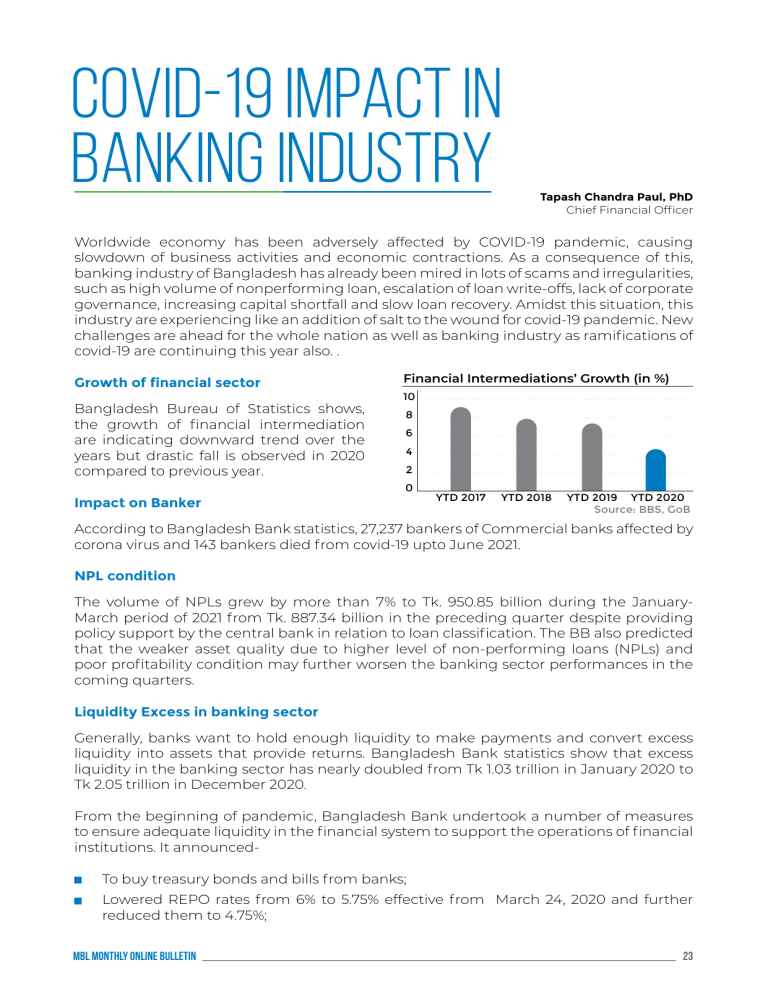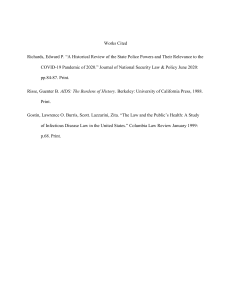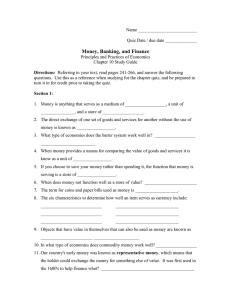
COVID-19 Impact in Banking Industry Tapash Chandra Paul, PhD Chief Financial Officer Worldwide economy has been adversely affected by COVID-19 pandemic, causing slowdown of business activities and economic contractions. As a consequence of this, banking industry of Bangladesh has already been mired in lots of scams and irregularities, such as high volume of nonperforming loan, escalation of loan write-offs, lack of corporate governance, increasing capital shortfall and slow loan recovery. Amidst this situation, this industry are experiencing like an addition of salt to the wound for covid-19 pandemic. New challenges are ahead for the whole nation as well as banking industry as ramifications of covid-19 are continuing this year also. . Growth of financial sector Bangladesh Bureau of Statistics shows, the growth of financial intermediation are indicating downward trend over the years but drastic fall is observed in 2020 compared to previous year. Financial Intermediations’ Growth (in %) 10 8 6 4 2 0 Impact on Banker YTD 2017 YTD 2018 YTD 2019 YTD 2020 Source: BBS, GoB According to Bangladesh Bank statistics, 27,237 bankers of Commercial banks affected by corona virus and 143 bankers died from covid-19 upto June 2021. NPL condition The volume of NPLs grew by more than 7% to Tk. 950.85 billion during the JanuaryMarch period of 2021 from Tk. 887.34 billion in the preceding quarter despite providing policy support by the central bank in relation to loan classification. The BB also predicted that the weaker asset quality due to higher level of non-performing loans (NPLs) and poor profitability condition may further worsen the banking sector performances in the coming quarters. Liquidity Excess in banking sector Generally, banks want to hold enough liquidity to make payments and convert excess liquidity into assets that provide returns. Bangladesh Bank statistics show that excess liquidity in the banking sector has nearly doubled from Tk 1.03 trillion in January 2020 to Tk 2.05 trillion in December 2020. From the beginning of pandemic, Bangladesh Bank undertook a number of measures to ensure adequate liquidity in the financial system to support the operations of financial institutions. It announcedTo buy treasury bonds and bills from banks; Lowered REPO rates from 6% to 5.75% effective from March 24, 2020 and further reduced them to 4.75%; MBL MONTHLY ONLINE BULLETIN 23 Reduced Cash Reserve Ratio (CRR) from 5.0% to 4.5% (daily-basis) and from 5.5% to 5.0% (bi-weekly basis) , and again reduced it to 3.5% and 4 %, respectively from April 15, 2020; Increased advance-deposit ratio (ADR) for all the conventional banks from 85 per cent to 87 per cent, effective from April 15, 2020 ; Increased investment deposit ratio (IDR) for Islami Shariah-based banks and the conventional banks operating under Islamic Shariah rules from 90 per cent to 92 per cent, effective from April 15, 2020 . Private sector credit growth Private sector credit growth decreased further to 8.29 per cent in April 2021 on a year-onyear basis from 8.79 per cent a month ago mainly due to the second wave of the Covid-19 pandemic. Stimulus package Banks are the key player for implementation of Covid-19 related stimulus package. The major portion of these packages is in the form of liquidity support through the commercial banks. From the outset of the announcement of the COVID-19 liquidity support packages by the government, banks have been more willing to lend to large borrowers, but were hesitant to lend to small borrowers. In a “k” shaped economic recovery curve, the COVID-19 recovery path splits in two directions: large firms and public-sector institutions with direct access to government and central bank stimulus packages will make some areas of the economy recover fast but leave behind small and medium-sized enterprises (SMEs), bluecollar workers, and the under-pressure middle class. The design of the stimulus packages and their distribution services is leading to a mostly “k” shaped economic recovery path in Bangladesh. The allocation of COVID-19 response funding by the government In million USD In crore BDT As share of total As share COVID funding of GDP* Total liquidity support 11,839 99,450 79.59 3.54 Total fiscal stimulus 3,037 25,503 20.41 0.91 Total COVID-19 funding 14,876 1,24,953 100.00 4.45 Source: Ministry of Finance, Government of Bangladesh (MoF, 2020) Note: * Assuming that GDP is equal to USD 334,000 million, as per the GDP for FY2020 in the national budget documents of FY2021. Moratorium Facility for businessmen Citing the second wave of COVID-19, the central bank was extended its moratorium on loan classification by three more months, up to 30 June 2021. Mapping the impacts of the COVID-19 pandemic for banks The following figure shows the mapping of possible implications of the COVID-19 pandemic for banks in a ‘no policy intervention’ scenario. As an immediate effect of lockdown across the economy, production has halted, demand for goods and services has slumped, factories and offices are completely or partly shut-down, transports and logistics are restricted, and public movement as a whole is highly restricted both domestically and internationally. MBL MONTHLY ONLINE BULLETIN 24 MBL MONTHLY ONLINE BULLETIN 25 THIRD WAVE Interruption of captial flows Distortion to Supply Chain Rise in Financial Risk and Instability Exchange Rates Volatility Loss of Employment and Income Price Level Shock Decreased loan and nonloan services demand Decreased savings and Increased withdrawal Temporary or permanent loan default FOURTH WAVE Banking Sector Impacts Long term Reduced asset/firm value Shock to capital adequacy Increased NPLs Reduced interest and non-interest income FIFTH WAVE Banking Sector Impacts Long term Post-pandemic The waves and the specific impacts are interrelated and interact in a complex way, eventually affecting bank survival, growth, and banking system stability, which could ignite systemic bank crisis if persists for a longer period. Interruption of Human Flows Distortion to Trade Flows Aggregate Demand Shock Aggregate Supply Shock Macroeconomic Impacts SECOND WAVE Impact Internationalized Short to Medium term Short to Medium term Initial Demand Shock Initial Production Shock Localized Direct Impacts FIRST WAVE Short term Pandemic begins A COVID-19 Pandemic Timeline Ways of recovering Resolving longer term structural challenges could accelerate the post-COVID-19 recovery. Reform priorities include a diversification of exports beyond the RMG sector, deepening the financial sector, improving urbanization, and strengthening public governance. Addressing infrastructure gaps would accelerate growth and reduce spatial disparities in opportunities across regions and within cities. Human capital development remains a priority as well. While Bangladesh’s ranking on the Human Capital Index is higher than the South Asian average, it is below the levels observed in comparator countries. Addressing vulnerability to climate risks would support the resilience of economic development to future shocks. Pivoting towards green growth could support the sustainability of development outcomes for the next generation. With the right policies and timely action, Bangladesh can accelerate its recovery from the economic downturn and continue to progress towards upper-middle income status. References: www.worldbank.org cpd.org.bd https://www.thedailystar.net/opinion/news/strong-banking-system-makes-strong-economy-1936077 https://thef inancialexpress.com.bd/views/views/economic-growth-in-bangladesh-and-the-role-ofbanking-sector-1547220114 https://thef inancialexpress.com.bd/views/covid-19-stimulus-packages-and-performance-of-thecountrys-banking-sector-1614174857 https://link.springer.com/article/10.1007/s43546-020-00013-wd MBL MONTHLY ONLINE BULLETIN 26



